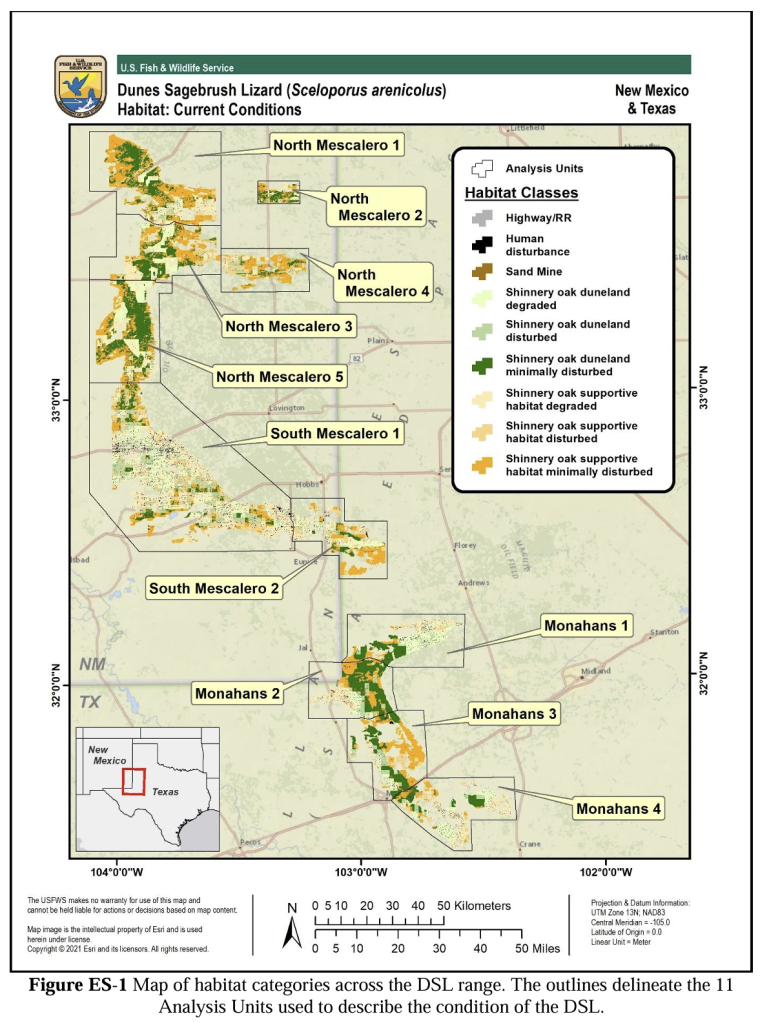The U.S. Fish and Wildlife Service (USFWS) listed the dune sagebrush lizard (DSL) as endangered under the Endangered Species Act (ESA). This final rule and “endangered” listing status will be in effect June 20, 2024. The USFWS did not designate critical habitat at this time but indicated a proposed rule to designate critical habitat is forthcoming within the next year. The USFWS identified habitat loss, fragmentation, and degradation particularly from oil and gas exploration and frac sand mining as the primary threats to the DSL. USFWS identified climate change and extreme drought as factors that compound the primary threats of habitat loss and fragmentation.
WILL MY PROJECTS BE AFFECTED?
The DSL’s narrow range is limited to shinnery oak sand dune ecosystems of eastern New Mexico and western Texas. This includes portions of Lea, Eddy, Chaves, and Roosevelt Counties of New Mexico, and Andrews, Winkler, Ward, and Crane Counties of Texas. This listing has implications for project proponents operating in the Permian Basin, particularly in Texas, where other triggers for federal regulatory involvement are few and far between. In the listing, the USFWS identified example circumstances in which incidental take may occur and for which ESA authorization may be warranted, including activities that destroy, alter, degrade, or remove shinnery oak duneland and shrubland vegetation that is likely to be occupied by DSL. The USFWS does not provide guidance about the kinds of activities that are likely to avoid incidental take of the DSL and may be conducted without ESA authorization.

LEARN MORE AND GET INVOLVED
If your project occurs in the range of the DSL, ESA compliance may include conducting interagency consultation, seeking an incidental take permit, participating in one of the existing voluntary conservation plans, or designing your project to avoid incidental take.
There are three existing voluntary conservation plans available for enrollment that offer regulatory assurances or streamlined consultation for non-federal and federal projects. Enrolled participants implement conservation measures to minimize impacts to the DSL and provide a net conservation benefit. Requirements and coverage areas vary by conservation plan. Enrollment into these plans must occur prior to June 20, 2024.
Voluntary Conservation Plans
- Candidate Conservation Agreement for the Lesser Prairie-Chicken (Tympanuchus pallidicinctus) and Sand Dune Lizard (Sceloporus arenicolus) in New Mexico, administered by the Center of Excellence (formerly the Center of Excellence for Hazardous Materials Management)
- Candidate Conservation Agreement with Assurances for the Dunes Sagebrush Lizard (Sceloporus arenicolus), a Texas-based conservation plan administered by Canyon Environmental, LLC
- Texas Conservation Plan for the Dunes Sagebrush Lizard (Sceloporus arenicolus), a Texas-based conservation plan administered by the American Conservation Fund
Once this listing rule is effective, non-federal project proponents working in a habitat occupied by the DSL may need to consider collaborating with USFWS on a habitat conservation plan and seeking an incidental take permit. Projects with a federal nexus must now undergo ESA Section 7 interagency consultation if the activity may affect the DSL. Conservation actions to address the impacts of take would be determined on a project-specific basis through coordination and consultation with USFWS.
SWCA CAN HELP
SWCA can help you understand whether and how the DSL listing may affect project planning, approvals, or implementation. We can also help you identify ESA compliance options that best meet your circumstances and priorities. Whether you are currently enrolled or considering enrollment in a voluntary conservation plan, SWCA has expert understanding of the DSL and voluntary conservation agreements. With state-permitted, Qualified DSL Biologists in New Mexico and Texas, we have significant experience designing and performing DSL surveys. Our team has developed DSL-specific survey protocols that have been incorporated into DSL best management practices and conservation agreements. Our services include:
• Desktop Reviews
• On-site Habitat Assessments
• Habitat Suitability Designation Evaluations
• Presence/Absence Surveys
• Section 7 Biological Assessments
• Section 10 Habitat Conservation Plans
nsmolensky [at] swca [dot] com (Nicole Smolensky )| Qualified DSL Biologist and ESA Regulatory Compliance Strategist, Texas
mmcmillan [at] swca [dot] com (Matt McMillan) | Qualified DSL Biologist, Texas Region
Jennifer [dot] Clayton [at] swca [dot] com (Jenn Clayton) | DSL Regulatory Compliance Strategist, New Mexico Region
aglen [at] swca [dot] com (Amanda Glen) | ESA Regulatory Compliance Strategist, Nationwide